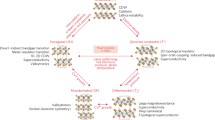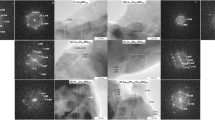Abstract
The thicknesses of the layers of a two-phase layered scale depend upon the individual stabilities, rates of growth, and molar volumes of the two compound products at a particular temperature. These factors and the partitioning of cations between the two compounds at their common interface are considered in order to develop a quantitative theory for the growth of double-layered scales on pure metals. Although layer thicknesses have been previously measured for several double-layered scales, all of the data necessary to calculate the relative thicknesses according to the present theory are not available. Thus, the theory cannot be verified at this time. However, the relative thicknesses of FeO and Fe3O4 which should form on Fe for 800⩽T⩽1090°C with\(P_{ O_{_2 } } = 10^{ - 11} atm\) are calculated. For two-phase layered scale formation in the oxidation of Co, other calculated values are discussed in terms of experimental results of other investigators.
Similar content being viewed by others
References
K. Fishbeck and F. Salzer,Metallwirtsch. 14, 733, 753 (1935).
W. Jost,Diffusion und chemische Reaktion in festen Stoffe (Steinkopff, Leipzig and Dresden, 1937), p. 166.
C. Wagner, “Reaktionen mit Metallen,” inHandbuch der Metallphysik, Vol. I, 2 (Leipzig, 1940), p. 143.
G. Valensi,Pittsburgh International Conference on Surface Reactions (Corrosion Publ. Co., Pittsburgh, 1948, p. 156.
K. Hauffe and W. Schottky,Halbleiterprobleme, Vol. V (Braunschweig, 1960), pp. 258–267.
G. V. Kidson,J. Nucl. Mater. 3, 21 (1961).
C. Wagner,Acta Met. 17, 99 (1969).
H. Schmalzried,Reactivity of Solids, G.-M. Schwab, ed. (Elsevier, Amsterdam, 1965), p. 204.
H.-G. Sockel,J. Cryst. Growth 12, 106 (1972).
C. Wagner,Z. Phys. Chem. B21, 25 (1933).
C. Wagner,Atom Movements (American Society for Metals, Cleveland, 1951), p. 153.
P. Vallet and P. Raccah,Mem. Sci. Rev. Met. 62, 1 (1965).
L. Himmel, R. F. Mehl, and C. E. Birchenall,Trans. AIME 197, 827 (1953).
P. Hembree and J. B. Wagner, Jr.,Trans. TMS-AIME 245, 1547 (1969).
C. E. Birchenall, “The Growth of Highly Defective Scales,” inHeterogeneous Kinetics at Elevated Temperatures, C. R. Belton and W. L. Worrell, eds. (Plenum Press, New York, 1970), pp. 253–267.
S. M. Klotsman, A. N. Timofeyev, and I. Sh. Trakhtenberg,Phys. Met. Metallog. 10, 93 (1961).
V. I. Izvekov,Akad. Nauk. Belarus SSR 1, 64 (1958).
H. Schmalzried,Z. Phys. Chem.,31, 184 (1962).
Handbook of Chemistry and Physics, R. C. Weast, ed. (Chemical Rubber Co., Cleveland, 1970–1971).
R. A. Rapp and D. A. Shores, “Solid Electrolyte Galvanic Cells,” inTechniques of Metals Research, Vol. IV, R. A. Rapp, ed. (Wiley, New York, 1970), p. 159.
R. Hales, A. C. Hill, and R. K. Wild,Corrosion Sci. 13, 325 (1973).
G. Simkovich and S. Kertoamodjo,Scripta Met. 7, 573 (1973).
A. G. Goursat and W. W. Smeltzer,Oxid. Met. 6, 101 (1973).
J. Paidassi,Rev. Met. LIV, 569 (1957).
J. Paidassi, M. G. Vallee, and P. Pepin,Mem. Sci. Rev. Met. 62, 789 (1965).
F. Morin and M. Rigaud,Can. Met. Quart. 9, 521 (1970).
Author information
Authors and Affiliations
Additional information
Supported by the U.S. Air Force (Aeronautical Research Laboratory), the U.S. Office of Naval Research, and an NSF Graduate Traineeship (GJY.).
Rights and permissions
About this article
Cite this article
Yurek, G.J., Hirth, J.P. & Rapp, R.A. The formation of two-phase layered scales on pure metals. Oxid Met 8, 265–281 (1974). https://doi.org/10.1007/BF00609944
Received:
Revised:
Issue Date:
DOI: https://doi.org/10.1007/BF00609944




